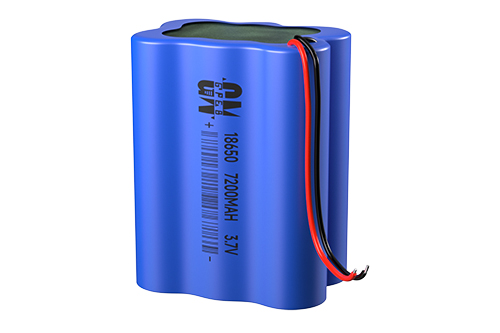Lithium - ion batteries are widely used in various applications, from consumer electronics to electric vehicles. Predicting their remaining useful life (RUL) accurately is of great significance for ensuring the safe and reliable operation of battery - powered systems, optimizing maintenance schedules, and extending the overall lifespan of the batteries. Establishing a reliable life prediction model involves several key steps and considerations.
1. Data Collection and Pre - processing
Data Sources: The first step in building a life prediction model is to collect relevant data. This includes battery voltage, current, temperature, and capacity data during charge - discharge cycles. For example, in an electric vehicle, the battery management system (BMS) continuously monitors and records these parameters. Laboratory - based battery testing also provides valuable data, where batteries are subjected to controlled charge - discharge profiles to simulate real - world usage conditions.
Data Cleaning: Once the data is collected, it needs to be cleaned. This involves removing outliers, which could be caused by sensor malfunctions or measurement errors. For instance, a sudden spike in voltage that is not consistent with the normal charge - discharge behavior may be an outlier. Data interpolation may also be required to fill in missing values. If a sensor fails to record data for a short period, interpolation techniques can estimate the missing values based on the surrounding data points.
Feature Extraction: From the raw data, relevant features that can reflect the battery's degradation state are extracted. Common features include the incremental capacity (IC) curve characteristics, which show the change in capacity with respect to voltage during charge or discharge. The peak value of the IC curve and the area under the peak are often used as health indicators. Another feature is the differential voltage (DV) curve, which can reveal the internal resistance changes and electrode reactions in the battery.
2. Selection of Prediction Model Algorithm
Empirical Models: Empirical models are based on experimental data and statistical relationships. One such model is the capacity fade model, which typically assumes a linear or non - linear relationship between the number of charge - discharge cycles and the battery's capacity. For example, the capacity of a lithium - ion battery may follow a power - law relationship with the number of cycles: \(C = C_0(1 + kN^n)\), where \(C\) is the capacity at cycle \(N\), \(C_0\) is the initial capacity, \(k\) and \(n\) are constants determined by experimental fitting. These models are relatively simple and computationally efficient but may lack accuracy in complex scenarios.
Machine Learning Models: Machine learning algorithms, such as artificial neural networks (ANNs) and support vector machines (SVMs), have gained popularity in battery life prediction. ANNs, especially long short - term memory (LSTM) networks, are well - suited for handling time - series data. In a LSTM network, the model can learn the temporal dependencies in the battery data, such as how the capacity degradation over time is related to previous charge - discharge conditions. SVMs can be used to classify the battery's health state based on the extracted features, and with appropriate regression techniques, can also predict the RUL. For example, by training an SVM on a set of battery data with known health states and RUL values, it can predict the RUL of new batteries based on their feature vectors.
Physics - based Models: Physics - based models rely on the fundamental electrochemical and physical principles governing battery operation. These models, such as the equivalent circuit model (ECM) and the porous electrode model, can accurately describe the internal processes in the battery, including ion diffusion, charge transfer, and electrode reactions. However, they often require a large number of parameters, which are difficult to measure accurately in real - world applications. For example, the ECM represents the battery as an equivalent circuit with resistors, capacitors, and voltage sources, and the parameters of these circuit elements are related to the battery's internal resistance, capacitance, and open - circuit voltage. By solving the circuit equations, the battery's voltage and current responses can be predicted, which in turn can be used to estimate the RUL.
3. Model Training and Validation
Training Process: After selecting the model algorithm, the model is trained using the pre - processed data. In the case of machine learning models, a large amount of labeled data (data with known RUL values) is used to adjust the model's parameters. For example, in training an ANN, the weights and biases of the neurons are adjusted iteratively to minimize the error between the predicted RUL and the actual RUL in the training data. The training process may involve techniques such as gradient descent to update the parameters in the direction that reduces the error.
Validation and Testing: To ensure the reliability of the model, it needs to be validated and tested. Validation is typically done using a separate set of data (validation data) that is not used in the training process. The model's performance on the validation data is evaluated using metrics such as mean squared error (MSE), root mean squared error (RMSE), and mean absolute error (MAE). For example, an RMSE of less than 5% of the battery's initial capacity may be considered an acceptable level of accuracy for a life prediction model. After validation, the model is tested on a completely new set of data (test data) to further assess its generalization ability. If the model performs well on both the validation and test data, it can be considered a reliable life prediction model.
establishing a lithium - ion battery life prediction model requires careful data collection and pre - processing, selection of an appropriate model algorithm, and rigorous training and validation. By accurately predicting the RUL, users can make informed decisions about battery replacement and maintenance, leading to more efficient and sustainable use of lithium - ion batteries.
Read recommendations:
501825 180MAH 3.7V
Model and specification of square lithium battery
Capacity of Cylindrical Lithium Batteries
48v 100ah lithium battery pack
battery 18650 genuine











































 360° FACTORY VR TOUR
360° FACTORY VR TOUR
 Whatsapp
Whatsapp
 Tel
Tel Email
Email TOP
TOP